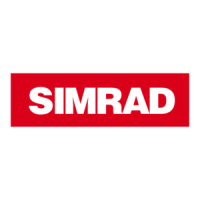Cable layout
135
857-164342 / Rev.C
2 Enter the name of the selected RS-232 port and the
communication parameters.
Annotation
Annotation messages may be input on the same serial line as the
navigation system. The $??ATS format is used, and it has the
following format..
$??ATS,this is a test<CR><LF>
The telegram header consists of:
1 the $ character
2 two letters ?? (disregarded by the echo sounder, identifies
the sender of the telegram)
3 three letters ATS (Annotation Text String - identifies the
type of NMEA telegram).
4 a comma (NMEA separation character).
5 Text string (The echo sounder handles the string as an
ordinary text. You can not use commas in the text string!)
6 A carriage-return and line-feed pair completes the
telegram.
The ASCII telegram with the external annotation must be
connected to the same serial line as the navigation system.
Depth output
The current depth from a defined transceiver channel can be
sent out on a chosen serial line. One or more of the following
serial lines can be used:
• Heave Sensor
• Navigation Interface
• Trawl Interface
The dialogue boxes used to control these interfaces also include
a button to open the Depth Output dialogue box. From this
dialogue, you can select from three different types of NMEA
depth telegrams.
• The $SDDBS telegram contains the depth below the surface.
• The $SDDBT telegram contains the depth below the
transducer.
• The $SDDPT telegram contains the depth below the
transducer and the distance between the transducer and the
waterline.

